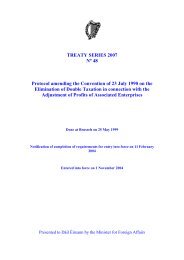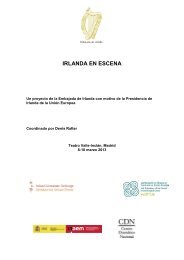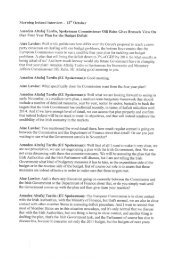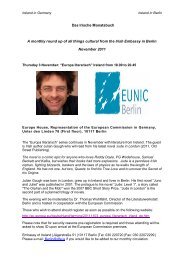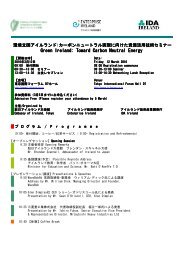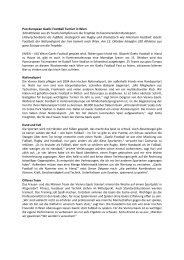Country Strategy Paper - Embassy of Ireland in Uganda
Country Strategy Paper - Embassy of Ireland in Uganda
Country Strategy Paper - Embassy of Ireland in Uganda
You also want an ePaper? Increase the reach of your titles
YUMPU automatically turns print PDFs into web optimized ePapers that Google loves.
<strong>Country</strong> <strong>Strategy</strong> <strong>Paper</strong><br />
<strong>Uganda</strong> 2007–2009
Front cover pic: Children from the Karamoja district <strong>of</strong> north-eastern <strong>Uganda</strong>.
“ The overall goal <strong>of</strong> the <strong>Country</strong> <strong>Strategy</strong> <strong>Paper</strong> is to<br />
support the Government <strong>of</strong> <strong>Uganda</strong> <strong>in</strong> its efforts to<br />
reduce poverty and promote susta<strong>in</strong>able development<br />
for <strong>Uganda</strong>n men and women.<br />
”<br />
<strong>Country</strong> <strong>Strategy</strong> <strong>Paper</strong> - <strong>Uganda</strong> 2007–2009<br />
<strong>Country</strong> <strong>Strategy</strong> <strong>Paper</strong><br />
<strong>Uganda</strong> 2007–2009
<strong>Country</strong> <strong>Strategy</strong> <strong>Paper</strong> - <strong>Uganda</strong> 2007–2009
Contents<br />
Foreword 4<br />
Executive Summary 5<br />
1 Background 6<br />
1.1 Political context 6<br />
1.2 Development context 6<br />
1.3 Policy framework for the CSP 7<br />
2. The Irish Aid Programme 8<br />
2.1 CSP 2004-2006 8<br />
2.2 Lessons learned 9<br />
3. CSP 2007-2009 10<br />
3.1 Goal and objectives 10<br />
3.2 Focus <strong>of</strong> the programme 10<br />
3.2.1 Economic management 11<br />
3.2.2 Governance 11<br />
3.3.3 Human development 12<br />
4 Cross-cutt<strong>in</strong>g Issues 13<br />
4.1 Governance 13<br />
4.2 HIV and AIDS 13<br />
4.3 Gender 13<br />
4.4 Ma<strong>in</strong>stream<strong>in</strong>g 14<br />
5 Monitor<strong>in</strong>g 15<br />
6 Risk 16<br />
7 Management 16<br />
8 Budget 17<br />
Abbreviations 18<br />
Image credits 18
<strong>Country</strong> <strong>Strategy</strong> <strong>Paper</strong> - <strong>Uganda</strong> 2007–2009<br />
Foreword<br />
This <strong>Country</strong> <strong>Strategy</strong> <strong>Paper</strong> (CSP) sets out the rationale and context<br />
for <strong>Ireland</strong>’s cont<strong>in</strong>ued support to <strong>Uganda</strong> for the period 2007-2009.<br />
It shows how we will achieve our goal <strong>of</strong> support<strong>in</strong>g the Government<br />
<strong>of</strong> <strong>Uganda</strong> <strong>in</strong> its efforts to reduce poverty and promote susta<strong>in</strong>able<br />
development for <strong>Uganda</strong>n men and women.<br />
Over the past fourteen years, the Irish Government has<br />
steadily <strong>in</strong>creased its development aid programme <strong>in</strong><br />
<strong>Uganda</strong>, work<strong>in</strong>g closely with the Government <strong>in</strong> support<br />
<strong>of</strong> its Poverty Eradication Assistance Programme (PEAP)<br />
and the atta<strong>in</strong>ment <strong>of</strong> the Millennium Development Goals<br />
(MDGs).<br />
The CSP 2007-2009 is significant <strong>in</strong> that this is the first<br />
time that such a strategy is derived from a multi-donor<br />
Jo<strong>in</strong>t Assistance <strong>Strategy</strong> for <strong>Uganda</strong> (UJAS), which<br />
<strong>Ireland</strong> jo<strong>in</strong>ed <strong>in</strong> 2006. The UJAS – follow<strong>in</strong>g from the<br />
commitments entered <strong>in</strong>to <strong>in</strong> the Paris Declaration on Aid<br />
Effectiveness - provides for a more coherent and better<br />
aligned delivery <strong>of</strong> aid <strong>in</strong> <strong>Uganda</strong>. It is the donors’ jo<strong>in</strong>t<br />
response to the PEAP, enabl<strong>in</strong>g more useful collaboration,<br />
and focus<strong>in</strong>g on results and outcomes.<br />
The CSP 2007-2009 amounts to an elaboration <strong>of</strong> the<br />
contribution Irish Aid will make with<strong>in</strong> the UJAS framework.<br />
In the course <strong>of</strong> develop<strong>in</strong>g this strategy there has been<br />
an emphasis on what Irish Aid has been do<strong>in</strong>g well <strong>in</strong><br />
<strong>Uganda</strong> and how we can build on our successes. A donor<br />
and Government Division <strong>of</strong> Labour exercise, which has<br />
been ongo<strong>in</strong>g, provided the opportunity to rationalise our<br />
programme, streaml<strong>in</strong>e our engagement with partners <strong>in</strong><br />
Government and civil society, and concentrate more on<br />
where our comparative advantage lies.<br />
As outl<strong>in</strong>ed <strong>in</strong> the document, Irish Aid will focus on three<br />
key areas, namely: education, governance and HIV and<br />
AIDS, while at the same time cont<strong>in</strong>u<strong>in</strong>g to support the<br />
Poverty Action Fund (PAF). The priority issues <strong>of</strong> gender<br />
equality, governance, HIV and AIDS and the environment<br />
will be ma<strong>in</strong>streamed as a central element <strong>of</strong> what we do.<br />
In light <strong>of</strong> the Irish Government’s commitment to reach<br />
the United Nations target for development assistance<br />
by 2012, and <strong>in</strong> l<strong>in</strong>e with the UJAS, the CSP 2007-2009<br />
provides a mechanism whereby aid can be <strong>in</strong>creased if<br />
the Government <strong>of</strong> <strong>Uganda</strong> cont<strong>in</strong>ues to perform well <strong>in</strong> a<br />
number <strong>of</strong> key areas. However, the budget also conta<strong>in</strong>s a<br />
mechanism whereby it can be decreased should there be<br />
a deterioration <strong>in</strong> these key areas.<br />
Irish Aid is determ<strong>in</strong>ed to work together with the <strong>Uganda</strong>n<br />
Government, civil society and our donor partners to face<br />
head-on the challenges <strong>in</strong> each <strong>of</strong> the sectors we have<br />
committed to <strong>in</strong> the com<strong>in</strong>g three years. We will do this<br />
<strong>in</strong> order to contribute to development outcomes that will<br />
benefit the poorest segments <strong>of</strong> the population <strong>in</strong> <strong>Uganda</strong><br />
<strong>in</strong> a real and last<strong>in</strong>g way.<br />
Á<strong>in</strong>e Hearns<br />
Head <strong>of</strong> Mission,<br />
<strong>Embassy</strong> <strong>of</strong> <strong>Ireland</strong>, Kampala.
WESTERN<br />
SAHARA<br />
SENEGAL<br />
GAMBIA<br />
GUINEA-BISSAU<br />
GUINEA<br />
PORTUGAL<br />
MAURITANIA<br />
Executive Summary<br />
In 2007, <strong>Uganda</strong> was ranked 154 (out <strong>of</strong> 177 countries) on<br />
the United Nations Human Development Index (HDI) with<br />
an average life expectancy at birth <strong>of</strong> 49.7 years. This was<br />
a drop <strong>of</strong> n<strong>in</strong>e places on the previous year. It is clear that<br />
while steady ga<strong>in</strong>s have been made <strong>in</strong> some <strong>of</strong> the social<br />
sectors, significant challenges rema<strong>in</strong> for <strong>Uganda</strong> as it<br />
tackles chronic poverty and <strong>in</strong>equality.<br />
This CSP sets out the Irish Aid strategy <strong>in</strong> <strong>Uganda</strong> for<br />
the period 2007-2009. It is guided by the White <strong>Paper</strong> on<br />
Irish Aid and <strong>Ireland</strong>’s commitment towards achiev<strong>in</strong>g<br />
the Millennium Development Goals. It has been drawn<br />
up with development partners as part <strong>of</strong> the <strong>Uganda</strong><br />
Jo<strong>in</strong>t Assistance <strong>Strategy</strong>, which is a jo<strong>in</strong>t strategy for<br />
development assistance that responds to the <strong>Uganda</strong>n<br />
Government’s Poverty Eradication Action Plan (PEAP). The<br />
CSP is Irish Aid’s contribution to that process.<br />
The approach <strong>in</strong> the CSP is structured around the pillars<br />
<strong>of</strong> the PEAP. It <strong>in</strong>volves a focussed and enhanced<br />
engagement <strong>in</strong> the economic management, governance<br />
and human development pillars <strong>of</strong> the PEAP, and is<br />
balanced by reduced direct <strong>in</strong>volvement <strong>in</strong> other areas, <strong>in</strong><br />
particular agriculture and health.<br />
SPAIN<br />
MOROCCO<br />
MALI<br />
ALGERIA<br />
BURKINA<br />
FASO<br />
BENIN<br />
SIERRA LEONE COTE TOGO<br />
LIBERIA<br />
D'IVOIRE<br />
GHANA<br />
TUNISIA<br />
NIGER<br />
NIGERIA<br />
EQUATORIAL GUINEA<br />
MALTA<br />
CAMEROON<br />
LIBYA<br />
GABON REP.<br />
OF CONGO<br />
NAMIBIA<br />
GREECE<br />
CHAD<br />
CENTRAL AFRICAN<br />
REPUBLIC<br />
ANGOLA<br />
DEM. REP.<br />
OF CONGO<br />
ZAMBIA<br />
BOTSWANA<br />
SOUTH AFRICA<br />
ARMENIA<br />
TURKEY<br />
SYRIA<br />
CYPRUS<br />
LEBANON<br />
IRAQ<br />
PALESTINE<br />
ISRAEL JORDAN<br />
EGYPT<br />
SUDAN<br />
RWANDA<br />
BURUNDI<br />
ZIMBABWE<br />
SWAZILAND<br />
LESOTHO<br />
ERITREA<br />
MOZAMBIQUE<br />
ETHIOPIA<br />
UGANDA<br />
KENYA<br />
TANZANIA<br />
MALAWI<br />
AZERBAIJAN<br />
TURKMENISTAN<br />
KUWAIT<br />
SAUDI ARABIA<br />
YEMEN<br />
DJIBOUTI<br />
SOMALIA<br />
MADAGASCAR<br />
IRAN<br />
UAE<br />
OMAN<br />
<strong>Country</strong> <strong>Strategy</strong> <strong>Paper</strong> - <strong>Uganda</strong> 2007–2009<br />
Dur<strong>in</strong>g the last CSP period 2004-2006, the programme<br />
budget totalled €96.5m. The total programme <strong>of</strong> support<br />
for the 2007-2009 CSP is projected at over €124 million.<br />
Overall direct bilateral support is projected to <strong>in</strong>crease<br />
from €35.5 million <strong>in</strong> 2007 to almost €45 million <strong>in</strong> 2009.<br />
Additional support will be channelled through NGOs and<br />
<strong>in</strong>ternational organisations.<br />
The first section <strong>of</strong> the CSP describes the context and<br />
rationale for the Irish Aid programme <strong>in</strong> <strong>Uganda</strong>. This is<br />
followed by a section on the lessons learned from the<br />
previous CSP and a description <strong>of</strong> the 2007-2009 strategy.<br />
The f<strong>in</strong>al section details how Irish Aid will manage the<br />
implementation <strong>of</strong> the programme over the three year<br />
period.<br />
AFGHANISTAN<br />
DEM. REP.<br />
OF THE CONGO<br />
Lake<br />
Edward<br />
RWANDA<br />
L. George<br />
ARUA<br />
Lake Albert<br />
MBARARA<br />
TANZANIA<br />
GULU<br />
ENTEBBE<br />
SUDAN<br />
Lake Kwania<br />
KAMPALA<br />
Lake Victoria<br />
JINJA<br />
SOROTI<br />
Lake Kyoga<br />
MBALE<br />
TORORO<br />
L. Bis<strong>in</strong>a<br />
MOROTO<br />
TANZANIA<br />
KENYA
<strong>Country</strong> <strong>Strategy</strong> <strong>Paper</strong> - <strong>Uganda</strong> 2007–2009<br />
1. Background<br />
1.1 Political context<br />
The political climate <strong>in</strong> <strong>Uganda</strong>, <strong>in</strong>clud<strong>in</strong>g relations with<br />
its neighbours, rema<strong>in</strong>s stable. The country has shown<br />
leadership on governance and on tackl<strong>in</strong>g HIV and AIDS. The<br />
first multi-party elections <strong>in</strong> over twenty years were held <strong>in</strong><br />
February 2006. The Juba Peace Process between the Lord’s<br />
Resistance Army (LRA) and the Government <strong>of</strong> <strong>Uganda</strong> has<br />
brought about a ceasefire after two decades <strong>of</strong> devastat<strong>in</strong>g<br />
conflict <strong>in</strong> northern <strong>Uganda</strong>. However, poverty is still endemic<br />
<strong>in</strong> <strong>Uganda</strong>, a country fac<strong>in</strong>g, like so many others <strong>in</strong> the<br />
region, the challenges <strong>of</strong> environmental degradation, rapid<br />
population growth, <strong>in</strong>stability, and governance shortfalls.<br />
The first multiparty elections resulted <strong>in</strong> the re-election for<br />
a third term <strong>of</strong> President Yoweri Museveni and an overall<br />
majority <strong>in</strong> Parliament for his party, the National Resistance<br />
Movement (NRM). While the elections themselves were<br />
conducted <strong>in</strong> a transparent, relatively peaceful and free<br />
atmosphere, <strong>in</strong>ternational confidence <strong>in</strong> the fairness <strong>of</strong> the<br />
process as a whole was underm<strong>in</strong>ed by the arrest and trial<br />
on charges <strong>of</strong> rape and treason <strong>of</strong> the lead<strong>in</strong>g opposition<br />
candidate dur<strong>in</strong>g the election campaign. The EU Election<br />
Observation Mission <strong>in</strong> its f<strong>in</strong>al report described the<br />
elections as “generally transparent, relatively peaceful, and<br />
[…] held <strong>in</strong> an atmosphere <strong>in</strong> which freedoms <strong>of</strong> expression,<br />
assembly and association were more widely respected<br />
than hitherto”. The report went on to say however that<br />
“the elections fell short <strong>of</strong> full compliance with <strong>in</strong>ternational<br />
pr<strong>in</strong>ciples for genu<strong>in</strong>e democratic elections, <strong>in</strong> particular<br />
because a level play<strong>in</strong>g field was not <strong>in</strong> place”.<br />
S<strong>in</strong>ce the election, Parliament structures and functions<br />
appear to be operat<strong>in</strong>g well. Opposition parties have been<br />
given the Chair <strong>of</strong> government committees and there<br />
appears to be a genu<strong>in</strong>e commitment from all parties<br />
<strong>in</strong>clud<strong>in</strong>g Government, to work together <strong>in</strong> a democratic<br />
manner to develop a fully function<strong>in</strong>g democratic system.<br />
The twenty-year military conflict <strong>in</strong> northern <strong>Uganda</strong>,<br />
which has been the cause <strong>of</strong> much suffer<strong>in</strong>g and been<br />
a destabilis<strong>in</strong>g factor for the country and the region, has<br />
abated. A ceasefire with the Lord’s Resistance Army<br />
(LRA) <strong>in</strong> northern <strong>Uganda</strong> has held almost completely<br />
s<strong>in</strong>ce August 2006, and the Juba peace process aimed at<br />
resolv<strong>in</strong>g that conflict got back on track <strong>in</strong> April 2007. UN<br />
Special Envoy Chissano undertook a regional tour <strong>in</strong> August<br />
2007, dur<strong>in</strong>g which he met with the presidents <strong>of</strong> <strong>Uganda</strong><br />
and DRC with a view to encourag<strong>in</strong>g restra<strong>in</strong>t and keep<strong>in</strong>g<br />
the process on track. While major differences between the<br />
two sides rema<strong>in</strong>, the cease-fire cont<strong>in</strong>ues to hold and the<br />
peace process aimed at resolv<strong>in</strong>g that conflict is ongo<strong>in</strong>g.<br />
In response to grow<strong>in</strong>g <strong>in</strong>ternational pressure <strong>in</strong> relation<br />
to the humanitarian situation <strong>in</strong> northern <strong>Uganda</strong>, the<br />
Government launched the Jo<strong>in</strong>t Monitor<strong>in</strong>g Committee<br />
(JMC) <strong>in</strong> May 2006. This is headed up by the Office <strong>of</strong> the<br />
Prime M<strong>in</strong>ister (OPM) and br<strong>in</strong>gs together bilateral and<br />
multilateral partners, relevant m<strong>in</strong>istries and district leaders.<br />
The JMC quickly put together a short-term emergency action<br />
plan aimed at improv<strong>in</strong>g the humanitarian response <strong>in</strong> the<br />
<strong>in</strong>ternally displaced person (IDP) camps <strong>in</strong> northern <strong>Uganda</strong> 1 .<br />
Despite these broadly positive developments, issues <strong>of</strong><br />
concern rema<strong>in</strong>. These concerns justify vigilance on the<br />
part <strong>of</strong> donors. They are reflected <strong>in</strong> this CSP <strong>in</strong> a broadly<br />
cautious approach to the growth <strong>of</strong> the programme and<br />
<strong>in</strong> the emphasis it places on the governance element <strong>of</strong><br />
the package. It is reflected too <strong>in</strong> the design <strong>of</strong> the CSP<br />
which provides the flexibility to react <strong>in</strong> a timely and<br />
proportionate manner <strong>in</strong> the event <strong>of</strong> difficulties aris<strong>in</strong>g<br />
<strong>in</strong> future. These and related issues such as respect for<br />
human rights are followed closely by the donors through<br />
the Partners for Democracy and Good Governance Group<br />
(PDG) 2 which is the ma<strong>in</strong> forum for discussion <strong>of</strong> these<br />
issues with Government. <strong>Ireland</strong> took over as Chair <strong>of</strong> the<br />
PDG <strong>in</strong> January 2007.<br />
1.2 Development context<br />
<strong>Uganda</strong> is one <strong>of</strong> the poorest countries <strong>in</strong> the world,<br />
rank<strong>in</strong>g 154th out <strong>of</strong> 177 on the UNDP’s 2007 Human<br />
Development Index (HDI), a drop <strong>of</strong> n<strong>in</strong>e places on the<br />
2006 HDI. Poverty levels <strong>in</strong> <strong>Uganda</strong> decl<strong>in</strong>ed substantially<br />
between 1992 and 2005 from 56 % to 31 % <strong>of</strong> the<br />
population. However 20% <strong>of</strong> the people are locked <strong>in</strong><br />
chronic poverty and <strong>in</strong>equality is <strong>in</strong>creas<strong>in</strong>g. It has one<br />
<strong>of</strong> the highest rates <strong>of</strong> population growth <strong>in</strong> the world (at<br />
3.3% per annum) with the highest fertility rate evident <strong>in</strong><br />
the lowest wealth qu<strong>in</strong>tile. There is a widen<strong>in</strong>g <strong>in</strong>equality<br />
among and with<strong>in</strong> regions, as well as between rural and<br />
urban populations.<br />
Poverty <strong>in</strong> northern <strong>Uganda</strong> is particularly severe and<br />
numbers <strong>of</strong> those liv<strong>in</strong>g <strong>in</strong> absolute poverty <strong>in</strong>creased from<br />
3.3 million <strong>in</strong> 2002 to 3.9 million <strong>in</strong> 2004. This <strong>in</strong>crease<br />
has been put down to prolonged drought and to <strong>in</strong>security<br />
result<strong>in</strong>g from LRA attacks. In Karamoja, where cattle<br />
rustl<strong>in</strong>g is a significant problem, 80% <strong>of</strong> the people are not<br />
1 <strong>Ireland</strong> responded to this humanitarian crisis <strong>in</strong> 2006 by provid<strong>in</strong>g €2.5<br />
million to the Red Cross (ICRC) , Médec<strong>in</strong>s Sans Frontiers (MSF), and<br />
UN agencies through the Consolidated Appeals Process.<br />
2 This political group comprises <strong>of</strong> Heads <strong>of</strong> Mission <strong>of</strong> Bilateral and<br />
Multilateral Donors <strong>in</strong> <strong>Uganda</strong>.
meet<strong>in</strong>g their basic requirements. The social <strong>in</strong>dicators <strong>in</strong><br />
this sub-region, <strong>in</strong> terms <strong>of</strong> health, education, access to<br />
safe water and sanitation are the lowest <strong>in</strong> the country.<br />
The economy has suffered significantly from the energy<br />
crisis caused by low water levels <strong>in</strong> Lake Victoria result<strong>in</strong>g<br />
<strong>in</strong> <strong>in</strong>adequate hydroelectric capacity, as well as by<br />
prolonged drought affect<strong>in</strong>g agricultural output. Growth<br />
this year is estimated at 5.9% (based on an assumption<br />
that drought will not be a factor and that an oil-burn<strong>in</strong>g<br />
plant will be available to alleviate the power crisis). This<br />
is significantly lower than the 7% PEAP target needed to<br />
substantially impact on poverty reduction.<br />
The Government <strong>of</strong> <strong>Uganda</strong>’s Poverty Status Report<br />
(2005) published <strong>in</strong> June 2006, highlighted positive trends<br />
<strong>in</strong> access to services; greater quantity and diversity <strong>of</strong><br />
primary education, health cl<strong>in</strong>ics, and drug outlets and<br />
access to agricultural extension services; improved rural<br />
roads; more prevalent and dynamic markets and greater<br />
diversity <strong>in</strong> non-farm activities.<br />
However these trends are <strong>of</strong>fset by widen<strong>in</strong>g <strong>in</strong>equalities<br />
<strong>in</strong> service delivery and deterioration <strong>in</strong> renewable<br />
resources, thus <strong>in</strong>creas<strong>in</strong>g the vulnerability <strong>of</strong> the poor.<br />
While <strong>Uganda</strong> has made significant progress <strong>in</strong> improv<strong>in</strong>g<br />
household welfare, <strong>in</strong>come <strong>in</strong>equality and high fertility<br />
rates have comb<strong>in</strong>ed to counteract the positive effects <strong>of</strong><br />
growth on poverty.<br />
The National Household survey 2003/4 showed that<br />
women headed households were amongst the poorest<br />
<strong>in</strong> the country. The MDG Report (2005) shows that most<br />
health <strong>in</strong>dicators l<strong>in</strong>ked to gender <strong>in</strong>equality have shown<br />
little improvement. Women are disproportionately affected<br />
by HIV and AIDS with <strong>in</strong>fection rates <strong>of</strong> 7.5% aga<strong>in</strong>st 5%<br />
for men. Women <strong>in</strong> <strong>Uganda</strong> constitute up to 80% <strong>of</strong> the<br />
agricultural workforce but own only 7% <strong>of</strong> the land and<br />
control 30% <strong>of</strong> the agricultural <strong>in</strong>come. Girls and boys now<br />
have equal access to primary education but completion<br />
rates for boys far exceed that for girls. Teenage pregnancies<br />
at 39% <strong>of</strong> girls under 18, contributes to a high drop out rate.<br />
To counter this <strong>in</strong>equality, the <strong>Uganda</strong>n Constitution<br />
provides a comprehensive framework <strong>in</strong> which to address<br />
women’s rights, gender equality and affirmative action.<br />
A National Gender Policy was developed <strong>in</strong> 1997. A<br />
PEAP Gender Group was formed dur<strong>in</strong>g the last PEAP<br />
review. Despite these <strong>in</strong>itiatives, it is clear that significant<br />
<strong>in</strong>equalities and challenges rema<strong>in</strong> and that this is an area<br />
that must cont<strong>in</strong>ue to be prioritised.<br />
<strong>Country</strong> <strong>Strategy</strong> <strong>Paper</strong> - <strong>Uganda</strong> 2007–2009<br />
<strong>Uganda</strong> is however, mak<strong>in</strong>g real progress <strong>in</strong> many<br />
areas. The HIV and AIDS prevalence rate is currently at<br />
6.4%, while 78% <strong>of</strong> the population can access a health<br />
centre with<strong>in</strong> 5km <strong>of</strong> their home. <strong>Uganda</strong> is one <strong>of</strong> the<br />
few countries <strong>in</strong> sub-Saharan Africa that will meet the<br />
Millennium Development Goal <strong>of</strong> access to Universal<br />
Primary Education (UPE) by 2015 - the gender gap <strong>in</strong><br />
primary education has narrowed to almost 1:1. Under-five<br />
mortality rates have decl<strong>in</strong>ed from 180 per 1000 live births<br />
<strong>in</strong> 1990 to 152 per 1000 <strong>in</strong> 2005.<br />
1.3 Policy framework for<br />
the CSP<br />
<strong>Uganda</strong> has a long track record <strong>of</strong> develop<strong>in</strong>g appropriate<br />
poverty alleviation policies. The first Poverty Eradication<br />
Action Plan (PEAP) was developed <strong>in</strong> 1997 and it set out<br />
a strategy for eradicat<strong>in</strong>g absolute poverty by 2017. As<br />
a result, <strong>Uganda</strong> was the first country to benefit from<br />
the orig<strong>in</strong>al and enhanced HIPC (Highly Indebted Poor<br />
<strong>Country</strong>) debt relief <strong>in</strong>itiatives <strong>in</strong> 1998 and 2000. The<br />
timeframe <strong>of</strong> the current PEAP ends <strong>in</strong> June 2008.<br />
The PEAP is the over-arch<strong>in</strong>g framework to eradicate<br />
poverty <strong>in</strong> <strong>Uganda</strong>. It is grouped <strong>in</strong>to five <strong>in</strong>terl<strong>in</strong>ked pillars:<br />
(i) economic management;<br />
(ii) production, competitiveness and <strong>in</strong>comes;<br />
(iii) security, conflict-resolution and disaster-management;<br />
(iv) governance;<br />
(v) human development.<br />
A detailed Results and Policy Matrix has been developed<br />
which <strong>in</strong> turn is l<strong>in</strong>ked to the Poverty Reduction <strong>Strategy</strong><br />
Credit (PRSC) process <strong>of</strong> the World Bank . The PRSC is<br />
based on the World Bank’s <strong>Country</strong> Assistance <strong>Strategy</strong><br />
(CAS) and supports the implementation <strong>of</strong> the PEAP. Other<br />
development partners participate <strong>in</strong> the PRSC missions<br />
and evaluations and take the PRSC as their mechanism for<br />
assess<strong>in</strong>g progress to allow release <strong>of</strong> fund<strong>in</strong>g. A National<br />
Integrated Monitor<strong>in</strong>g and Evaluation <strong>Strategy</strong> (NIMES)<br />
framework under the auspices <strong>of</strong> Office <strong>of</strong> the Prime<br />
M<strong>in</strong>ister (OPM) helps to track overall progress.
<strong>Country</strong> <strong>Strategy</strong> <strong>Paper</strong> - <strong>Uganda</strong> 2007–2009<br />
2. The Irish Aid Programme<br />
2.1. CSP 2004-2006<br />
The CSP 2004-2006 operated with<strong>in</strong> the framework <strong>of</strong><br />
the PEAP. The total budget for the period was €96.5<br />
million. A further €4.57 million was provided for HIV and<br />
AIDS. Approximately 70% <strong>of</strong> the budget was channelled<br />
through central m<strong>in</strong>istries for social sector spend<strong>in</strong>g,<br />
Table 1 Irish Aid (<strong>Uganda</strong>) Support, 2004 – 2006<br />
Area Fund<strong>in</strong>g (<strong>in</strong> €) Engagement – dialogue<br />
Pillar One: Economic Management<br />
decentralisation and justice reform through the Poverty<br />
Action Fund. The rema<strong>in</strong><strong>in</strong>g 30% was provided as<br />
project support to civil society organizations, government<br />
<strong>in</strong>stitutions and directly to district development. Table 1<br />
provides an overview <strong>of</strong> the ma<strong>in</strong> areas <strong>of</strong> support.<br />
PAF 24,600,000 Research related to growth and poverty;<br />
Pillar Two: Production, Competitiveness and Incomes<br />
Public f<strong>in</strong>ancial management;<br />
Public service reform;<br />
Macro issues-IMF;<br />
PRSC and the prior actions.<br />
NAADS 2,500,000 PMA implementation;<br />
Pillar Three: Security, Conflict Resolution and Disaster Management<br />
Amnesty Commission<br />
Conflict resolution through Civil<br />
society<br />
Pillar Four: Governance<br />
Governance<br />
JLOS<br />
Juvenile Justice<br />
Decentralisation<br />
SDP<br />
Governance (General)<br />
Pillar Five: Human Development<br />
Education<br />
Health<br />
HIV and AIDS<br />
Covered under<br />
Governance (General)<br />
below<br />
19,921,689<br />
9,000,000<br />
279,374<br />
6,392,677<br />
1,245,621<br />
3,004,017<br />
18,700,000<br />
15,400,000<br />
11,000,000<br />
Agriculture Sector Work<strong>in</strong>g Group.<br />
Political dialogue;<br />
The amnesty process and re<strong>in</strong>tegration <strong>of</strong> former rebels;<br />
Conflict resolution by Government and civil society;<br />
Humanitarian <strong>in</strong>terventions;<br />
Ma<strong>in</strong>stream<strong>in</strong>g conflict across sectors.<br />
Political dialogue;<br />
Justice reform;<br />
Decentralisation and Local Government development;<br />
Engagement on thematic areas with Government and civil society:<br />
anti-corruption, human rights, democratisation.<br />
Education Sector Budget Work<strong>in</strong>g Group;<br />
Policy dialogue – particularly curriculum reform, teacher development<br />
and UPPET;<br />
Support to district development;<br />
Health Sector Budget Work<strong>in</strong>g Group;<br />
Policy dialogue – particularly human resources, malaria, immunisation;<br />
Support to health service delivery <strong>in</strong> districts affected by conflict;<br />
Policy dialogue – particularly prevention;<br />
Support to Government (MoES and UAC);<br />
Support to civil society for care and treatment and prevention.
2.2. Lessons learned<br />
The preparation <strong>of</strong> the CSP for 2007-2009 <strong>in</strong>volved a<br />
detailed review and analysis <strong>of</strong> the previous programme.<br />
The CSP takes account <strong>of</strong> lessons learned and draws on<br />
the Annual PEAP Implementation Review; Bi-annual PRSC<br />
mission reports; Jo<strong>in</strong>t Reviews <strong>of</strong> the Education, Health<br />
and Justice Law and Order Sectors; Annual Reports and<br />
<strong>in</strong>ternal reviews <strong>of</strong> the country programme; and a Division<br />
<strong>of</strong> Labour exercise underway amongst UJAS partners.<br />
Some <strong>of</strong> the key lessons <strong>in</strong>form<strong>in</strong>g the new strategy <strong>in</strong>clude:<br />
><br />
><br />
><br />
><br />
><br />
Most partners with whom Irish Aid is <strong>in</strong>volved require<br />
considerable capacity-build<strong>in</strong>g support. In the next<br />
phase, direct support will be provided to a reduced<br />
number <strong>of</strong> partners, whilst explor<strong>in</strong>g further use <strong>of</strong><br />
common modalities and basket fund arrangements;<br />
An appropriate mix <strong>of</strong> aid modalities, engag<strong>in</strong>g at<br />
various strategic levels, is central to achiev<strong>in</strong>g best<br />
results. Irish Aid presence <strong>in</strong> the districts ensures that<br />
the programme is grounded <strong>in</strong> reality. The challenge is<br />
to use this experience to address local development<br />
issues from with<strong>in</strong> national structures and to support<br />
dissem<strong>in</strong>ation <strong>of</strong> best practice at the national level;<br />
Irish Aid has been <strong>in</strong>volved <strong>in</strong> ma<strong>in</strong>stream<strong>in</strong>g<br />
governance, particularly <strong>in</strong> the education sector<br />
through budget work<strong>in</strong>g groups, school management<br />
committees and support to civil society organisations.<br />
There is a need to document this experience <strong>in</strong> order<br />
to provide a framework for ma<strong>in</strong>stream<strong>in</strong>g governance<br />
<strong>in</strong> other parts <strong>of</strong> the programme;<br />
Conflict responses should not be left to standalone<br />
plans, as has been the case up to now.<br />
There is a need to ensure that such responses are<br />
ma<strong>in</strong>streamed <strong>in</strong> sectoral approaches. In Karamoja<br />
and <strong>in</strong> northern <strong>Uganda</strong>, Irish Aid will support the l<strong>in</strong>e<br />
m<strong>in</strong>istries <strong>in</strong> their response to the conflict-affected<br />
areas with<strong>in</strong> sector plans. In addition, Irish Aid will<br />
focus its efforts where it has comparative advantage,<br />
and contract others where this is not the case;<br />
Experience over the last CSP showed the value <strong>of</strong><br />
active engagement <strong>in</strong> the budget process. Irish Aid<br />
will cont<strong>in</strong>ue to <strong>in</strong>volve itself at the macro and sector<br />
level to ensure that adequate resources are provided<br />
for PEAP priorities.<br />
<strong>Country</strong> <strong>Strategy</strong> <strong>Paper</strong> - <strong>Uganda</strong> 2007–2009<br />
Irish Aid has rationalised its support with<strong>in</strong> the Health and<br />
Agriculture sectors. This decision takes account <strong>of</strong> Irish<br />
Aid’s policy priorities, comparative advantage, levels <strong>of</strong><br />
current fund<strong>in</strong>g, number <strong>of</strong> like-m<strong>in</strong>ded donors active <strong>in</strong><br />
the sector and level <strong>of</strong> government commitment.<br />
To date Irish Aid f<strong>in</strong>ancial <strong>in</strong>volvement <strong>in</strong> agriculture has<br />
been relatively low. Expert competence is not available <strong>in</strong><br />
the current staff and a significant number <strong>of</strong> like-m<strong>in</strong>ded<br />
donors are engaged <strong>in</strong> the sector.<br />
In health too there are a large number <strong>of</strong> like-m<strong>in</strong>ded<br />
donors active <strong>in</strong> the sector. Irish support to this sector will<br />
cont<strong>in</strong>ue until 2008. Once sector support is phased out,<br />
future assistance will be provided through the Poverty<br />
Action Fund. Efforts are also be<strong>in</strong>g made to rationalise<br />
with<strong>in</strong> sectors and to reduce the number <strong>of</strong> projects and<br />
partners with whom Irish Aid engages.<br />
Young Karamojong woman, Kotido district, Karamoja.
0 <strong>Country</strong> <strong>Strategy</strong> <strong>Paper</strong> - <strong>Uganda</strong> 2007–2009<br />
3. CSP 2007-2009<br />
3.1. Goal and objectives<br />
The overall goal <strong>of</strong> Irish Aid <strong>in</strong> <strong>Uganda</strong> is:<br />
To support the Government <strong>of</strong> <strong>Uganda</strong>’s efforts to<br />
reduce poverty and promote susta<strong>in</strong>able development for<br />
<strong>Uganda</strong>n men and women.<br />
Irish Aid has identified six strategic objectives to<br />
achieve this goal. Although not directly aligned with<br />
PEAP objectives, they are consistent with them. These<br />
objectives will focus Irish Aid engagement; will provide the<br />
foundation for annual bus<strong>in</strong>ess plans; and will guide the<br />
<strong>in</strong>dicators chosen to monitor implementation <strong>of</strong> the CSP.<br />
The CSP strategic objectives are:<br />
1. To promote participatory development for both men<br />
and women, and strengthen accountability and the<br />
quality <strong>of</strong> democratic governance <strong>in</strong> <strong>Uganda</strong>;<br />
2. To promote gender equality, the empowerment <strong>of</strong><br />
women and a reduction <strong>in</strong> gender-based violence;<br />
3. To contribute to the reduction <strong>of</strong> HIV and AIDS <strong>in</strong><br />
<strong>Uganda</strong> and mitigate it’s effects;<br />
4. To ensure coherence between the Irish Aid country<br />
programme <strong>in</strong> <strong>Uganda</strong> and other Irish Aid assistance<br />
to civil society and multilateral organisations work<strong>in</strong>g<br />
<strong>in</strong> the country;<br />
A <strong>Uganda</strong>n hospital nurse.<br />
5. To promote aid effectiveness, harmonisation and<br />
alignment and broader partnership approaches to<br />
development cooperation;<br />
6. To build embassy capacity and <strong>in</strong>dividual staff<br />
competencies to ma<strong>in</strong>stream the environment <strong>in</strong>to<br />
subsequent Irish Aid programmes.<br />
These objectives identify the centrality <strong>of</strong> the four crosscutt<strong>in</strong>g<br />
issues <strong>of</strong> gender, HIV and AIDS, governance and<br />
the environment to the reduction <strong>of</strong> poverty. Reflect<strong>in</strong>g<br />
these issues <strong>in</strong> the strategic objectives ensures that these<br />
have a significant focus with<strong>in</strong> the Irish Aid programme.<br />
3.2 Focus <strong>of</strong> the<br />
Programme<br />
Dur<strong>in</strong>g this CSP, the Irish Aid programme is focused on<br />
support to education, HIV and AIDS and governance<br />
as well as provid<strong>in</strong>g f<strong>in</strong>ancial support to all PEAP Pillars<br />
through the Poverty Action Fund. Support to each <strong>of</strong> the<br />
sectors has been rationalised and the number <strong>of</strong> partners<br />
reduced. Fund<strong>in</strong>g is provided through a range <strong>of</strong> modalities<br />
- sector support, basket funds, projects, through<br />
multilateral organisations and civil society. Coord<strong>in</strong>ation<br />
with other donors and alignment with government<br />
priorities is ensured by build<strong>in</strong>g the programme around the<br />
PEAP, operat<strong>in</strong>g with<strong>in</strong> the UJAS Framework. In addition<br />
to provid<strong>in</strong>g fund<strong>in</strong>g, Irish Aid is engag<strong>in</strong>g with its various<br />
partners (a) to ensure that the programmes supported are<br />
effective and (b) to promote its policy objectives.<br />
Irish Aid expects to <strong>in</strong>crease its annual fund<strong>in</strong>g from €35.5<br />
million <strong>in</strong> 2007 to a potential €45 million over the next 3<br />
years. Most <strong>of</strong> these funds will be used <strong>in</strong> support <strong>of</strong> major<br />
national programmes as set out <strong>in</strong> the budget <strong>in</strong> section 8.<br />
The ma<strong>in</strong> areas <strong>of</strong> support are:<br />
><br />
><br />
><br />
Pillar 1 - Economic Management; enabl<strong>in</strong>g Irish Aid<br />
to assist <strong>in</strong> strengthen<strong>in</strong>g the budget process and<br />
support<strong>in</strong>g pro-poor economic policy reform;<br />
Pillar 4 - Governance; focuss<strong>in</strong>g on justice<br />
reform, public sector management, and democratic<br />
accountability;<br />
Pillar 5 - Human Development; focuss<strong>in</strong>g on<br />
education and HIV and AIDS.
3.2.1 Economic Management<br />
<strong>Uganda</strong>’s growth strategy is reflected <strong>in</strong> pillar 1 <strong>of</strong><br />
the PEAP. Irish Aid is engag<strong>in</strong>g <strong>in</strong> this pillar through<br />
support to the PAF as well as through policy dialogue<br />
on macroeconomic performance. Irish Aid’s support to<br />
the governance sector, which contributes to promot<strong>in</strong>g<br />
government accountability, is <strong>in</strong>tr<strong>in</strong>sically l<strong>in</strong>ked to its<br />
fund<strong>in</strong>g <strong>of</strong> the PAF.<br />
The PAF is a r<strong>in</strong>g-fenced fund which targets social sectors<br />
and excludes defence and public adm<strong>in</strong>istration expenditure.<br />
The Government guarantees that budgetary allocations<br />
with<strong>in</strong> these sectors will be protected from <strong>in</strong>-year budget<br />
cuts result<strong>in</strong>g from revenue shortfalls or any other factors<br />
and that actual disbursement will be at least 95% <strong>of</strong><br />
budgeted amounts. This promise has been honoured s<strong>in</strong>ce<br />
the fund was established <strong>in</strong> 1997. The bulk <strong>of</strong> PAF funds<br />
are channelled to districts as conditional grants for health,<br />
education, rural roads and agriculture. F<strong>in</strong>anc<strong>in</strong>g the Poverty<br />
Action Fund allows Irish Aid to support all five pillars <strong>of</strong> the<br />
PEAP and a broad range <strong>of</strong> poverty-reduc<strong>in</strong>g programmes 3 .<br />
The PAF also provides an entry po<strong>in</strong>t to macro-level<br />
policy dialogue and an opportunity to promote the goal<br />
and strategic objectives. Specifically, Irish Aid uses its<br />
position with<strong>in</strong> the various structures, such as the Donor<br />
Economist Group, to promote economic growth policies<br />
which are pro-poor, that is: broadly based, focused on<br />
areas <strong>in</strong> which poor people live, utilise the assets <strong>of</strong> the<br />
poor and provide markets for goods produced by the<br />
poor. Dur<strong>in</strong>g this CSP, Irish Aid will f<strong>in</strong>ance, either alone<br />
or jo<strong>in</strong>tly, poverty-related analytical work and will ensure<br />
that the analysis is gender sensitive and exam<strong>in</strong>es l<strong>in</strong>ks<br />
between pro-poor economic growth and HIV and AIDS.<br />
><br />
Support to the Private sector: This CSP directly<br />
contributes to the development <strong>of</strong> the private<br />
sector <strong>in</strong> a number <strong>of</strong> ways. Irish Aid, through its<br />
support <strong>of</strong> the PAF, supports the economic policy<br />
<strong>of</strong> the Government <strong>of</strong> <strong>Uganda</strong> - up to 15% <strong>of</strong> PAF<br />
expenditure is allocated to improv<strong>in</strong>g productivity,<br />
competitiveness and <strong>in</strong>comes. Through its support for<br />
Traidl<strong>in</strong>ks 4 , Irish Aid has facilitated the development<br />
3 The PAF programmes <strong>in</strong>clude primary education; post primary<br />
education and tra<strong>in</strong><strong>in</strong>g; district tertiary education; adult literacy; primary<br />
health care, water and sanitation; agricultural extension and key<br />
programmes aimed at <strong>in</strong>creas<strong>in</strong>g agricultural productivity; rural and<br />
urban roads; district and referral hospitals; AIDS orphans; improved<br />
adm<strong>in</strong>istration <strong>of</strong> justice; local government development; and poverty<br />
and government f<strong>in</strong>ancial statistics.<br />
4 Traidl<strong>in</strong>ks is a not-for-pr<strong>of</strong>it organisation and has its orig<strong>in</strong>s <strong>in</strong> the<br />
Private Sector Forum <strong>of</strong> 2004. The organisation explores how to<br />
build l<strong>in</strong>ks between the Irish bus<strong>in</strong>ess community and the Irish Aid<br />
programme <strong>in</strong> develop<strong>in</strong>g countries.<br />
<strong>Country</strong> <strong>Strategy</strong> <strong>Paper</strong> - <strong>Uganda</strong> 2007–2009<br />
<strong>of</strong> a number <strong>of</strong> <strong>Uganda</strong>n companies <strong>in</strong>clud<strong>in</strong>g the<br />
Rwenzori C<strong>of</strong>fee Company, and the development <strong>of</strong><br />
an export market place for f<strong>in</strong>ished products under<br />
the Heart <strong>of</strong> Africa brand. Irish Aid is also provid<strong>in</strong>g<br />
assistance through support to the Justice, Law and<br />
Order Sector, which aims to provide an environment<br />
conducive to <strong>in</strong>vestment, growth and wealth creation.<br />
3.2.2 Governance<br />
Irish Aid support for the governance pillar is concentrated<br />
on develop<strong>in</strong>g the capacity <strong>of</strong> the Government, on<br />
encourag<strong>in</strong>g responsiveness to the needs and aspirations<br />
<strong>of</strong> citizens <strong>in</strong> <strong>Uganda</strong>, and on promot<strong>in</strong>g transparency and<br />
accountability <strong>in</strong> State <strong>in</strong>stitutions. Irish Aid is support<strong>in</strong>g<br />
the follow<strong>in</strong>g areas:<br />
><br />
><br />
><br />
Justice Reform: Irish Aid is support<strong>in</strong>g the Justice,<br />
Law and Order Sector (JLOS) Strategic Investment<br />
Plan 2006 to 2011, which sets out a comprehensive<br />
approach to justice reform and to improv<strong>in</strong>g access<br />
to justice. It targets crim<strong>in</strong>al, commercial, land and<br />
family law areas. This is complemented by support for<br />
civil society organisations and for the <strong>Uganda</strong> Human<br />
Rights Commission (UHRC);<br />
Public Sector Management (PSM): To achieve<br />
last<strong>in</strong>g improvements <strong>in</strong> liv<strong>in</strong>g conditions, the<br />
capacity and accountability <strong>of</strong> public <strong>in</strong>stitutions<br />
needs to be strengthened. Irish Aid is support<strong>in</strong>g<br />
the strengthen<strong>in</strong>g <strong>of</strong> public sector management and<br />
accountability, with an emphasis on decentralisation,<br />
the rollout <strong>of</strong> public sector reform, and enhanced<br />
Public F<strong>in</strong>ancial Management. Irish Aid is support<strong>in</strong>g<br />
several <strong>in</strong>itiatives <strong>in</strong>clud<strong>in</strong>g: (i) sector support for<br />
the Local Government Sector Investment Plan; (ii)<br />
basket fund<strong>in</strong>g support for the Public Service Reform<br />
Programme and; (iii) basket fund<strong>in</strong>g support to the<br />
F<strong>in</strong>ancial Management and Accountability Programme<br />
(FINMAP). Support is also provided for an important<br />
civil society actor <strong>in</strong> decentralisation, the <strong>Uganda</strong> Local<br />
Governments Association (ULGA);<br />
Democratic Accountability: Irish Aid is support<strong>in</strong>g<br />
the promotion <strong>of</strong> democracy, political parties and<br />
civic education <strong>in</strong> the lead-up to presidential and<br />
parliamentary elections <strong>in</strong> 2011. This is largely be<strong>in</strong>g<br />
done through participation <strong>in</strong> and fund<strong>in</strong>g for a<br />
“Deepen<strong>in</strong>g Democracy Programme” basket fund.<br />
Components relate to civil society, civic education,<br />
media, parliament, the electoral commission, and<br />
political parties.
<strong>Country</strong> <strong>Strategy</strong> <strong>Paper</strong> - <strong>Uganda</strong> 2007–2009<br />
3.3.3 Human Development<br />
Support under this pillar is provided to programmes<br />
<strong>in</strong> education and HIV and AIDS. Irish Aid is assist<strong>in</strong>g<br />
the M<strong>in</strong>istry <strong>of</strong> Education and Sport to implement the<br />
Education Sector Strategic Plan. It is also work<strong>in</strong>g through<br />
civil society organisations. Activities <strong>in</strong>clude curriculum<br />
and teacher development, ICT, bursaries and adult literacy.<br />
Fund<strong>in</strong>g is also be<strong>in</strong>g provided to post-primary education<br />
and tra<strong>in</strong><strong>in</strong>g <strong>in</strong> the Karamoja region. Gender-based violence<br />
at school level is be<strong>in</strong>g <strong>in</strong>vestigated and an appropriate<br />
response is currently be<strong>in</strong>g designed.<br />
Irish Aid’s HIV and AIDS programme <strong>in</strong> <strong>Uganda</strong> will<br />
cont<strong>in</strong>ue to support the <strong>Uganda</strong>n AIDS Commission and<br />
the M<strong>in</strong>istry <strong>of</strong> Local Government. Fund<strong>in</strong>g will also be<br />
provided to a jo<strong>in</strong>t donor basket designed to coord<strong>in</strong>ate<br />
and streaml<strong>in</strong>e the civil society response to HIV and AIDS<br />
<strong>in</strong> the country. Irish Aid has been selected to represent<br />
the AIDS Development Partners on the National Strategic<br />
Framework (NSF) Task Force to provide overall guidance<br />
for develop<strong>in</strong>g the new NSF 2006-2011. Irish Aid is<br />
work<strong>in</strong>g to ensure the NSF deals effectively with issues<br />
such as universal access to HIV prevention and treatment<br />
and its gender dimensions.<br />
Irish Aid is implement<strong>in</strong>g its exit strategy for the health<br />
sector. The withdrawal is be<strong>in</strong>g carried out <strong>in</strong> a phased<br />
basis over the course <strong>of</strong> the CSP. Irish Aid released its f<strong>in</strong>al<br />
commitment to the M<strong>in</strong>istry <strong>of</strong> Health’s sector programme<br />
<strong>in</strong> 2007. In 2008, support will be provided to the Primary<br />
Health Care Tra<strong>in</strong><strong>in</strong>g Programme, implemented by AMREF.<br />
Overall, the programme has become more focused. This<br />
has led to a more strategic approach <strong>in</strong> those sectors<br />
<strong>in</strong> which Irish Aid has a comparative advantage. It also<br />
provides a basis for exploit<strong>in</strong>g programme l<strong>in</strong>kages more<br />
effectively. The programme is positioned at the heart <strong>of</strong><br />
national processes, <strong>in</strong>volv<strong>in</strong>g an enhanced engagement<br />
<strong>in</strong> education, HIV and AIDS and governance, as well as<br />
provid<strong>in</strong>g support to all PEAP pillars through the Poverty<br />
Action Fund.<br />
Research <strong>in</strong> the Soil Science department <strong>of</strong> Makarere University.
4. Cross-cutt<strong>in</strong>g Issues<br />
Progress<strong>in</strong>g the Irish Aid cross-cutt<strong>in</strong>g issues - gender<br />
equality, HIV and AIDS, governance and the environment<br />
- is essential to susta<strong>in</strong>able poverty reduction. Each <strong>of</strong><br />
these policy priorities is addressed through either specific<br />
programmes or ma<strong>in</strong>stream<strong>in</strong>g. Dur<strong>in</strong>g this CSP, tak<strong>in</strong>g<br />
account <strong>of</strong> the need to match resources to ambition, Irish Aid<br />
is focus<strong>in</strong>g its efforts on gender, governance and HIV<br />
and AIDS.<br />
4.1 Governance<br />
The White <strong>Paper</strong> on Irish Aid emphasises the importance<br />
<strong>of</strong> governance to achiev<strong>in</strong>g susta<strong>in</strong>able development.<br />
Weak governance and corruption greatly h<strong>in</strong>der<br />
development and reduce the effectiveness and impact <strong>of</strong><br />
development assistance.<br />
Corruption with<strong>in</strong> the public sector rema<strong>in</strong>s a challenge<br />
and carries high risks for the programme. A particular<br />
focus has been given to this area <strong>in</strong> the CSP. Irish Aid is<br />
address<strong>in</strong>g this through various channels. In 2002, Irish<br />
Aid supported the Inspectorate <strong>of</strong> Government to conduct<br />
a national <strong>in</strong>tegrity survey, which led to the development<br />
<strong>of</strong> the national anti- corruption strategy. Support has<br />
been given to oversight bodies such as the Directorate <strong>of</strong><br />
Ethics and Integrity to build capacity and also <strong>in</strong> the area<br />
<strong>of</strong> legislative reform. Irish Aid has provided support to the<br />
<strong>Uganda</strong> Debt Network and the Anti-Corruption Coalition,<br />
which are <strong>in</strong>volved <strong>in</strong> rais<strong>in</strong>g popular awareness. Irish<br />
Aid also plays an active role <strong>in</strong> the World Bank Poverty<br />
Reduction Support Credit which addresses corruption.<br />
Assistance to these bodies as well as to civil society<br />
organisations and <strong>in</strong>dependent media will form an<br />
important part <strong>of</strong> a balanced Irish Aid response.<br />
<strong>Uganda</strong> has been implement<strong>in</strong>g a wide range <strong>of</strong> Public<br />
F<strong>in</strong>ancial Management (PFM) reform measures aimed at<br />
support<strong>in</strong>g the goal <strong>of</strong> poverty reduction through good<br />
governance. Whilst these have resulted <strong>in</strong> improvements<br />
<strong>in</strong> a number <strong>of</strong> areas, e.g. legislation, pr<strong>of</strong>essional capacity<br />
and core Government computerisation, they have not yet<br />
been completed or created susta<strong>in</strong>able improvements.<br />
The Government is keen to improve the<br />
comprehensiveness, transparency and coverage <strong>of</strong> its<br />
f<strong>in</strong>ancial transactions. The goal <strong>of</strong> the Government’s<br />
recently established F<strong>in</strong>ancial Management and<br />
Accountability Programme (FINMAP) is to strengthen<br />
public f<strong>in</strong>ancial management at central and local<br />
government levels to ensure accountability and reduce<br />
opportunities for corruption. Irish Aid has provided<br />
<strong>Country</strong> <strong>Strategy</strong> <strong>Paper</strong> - <strong>Uganda</strong> 2007–2009<br />
technical <strong>in</strong>put <strong>in</strong> the preparation <strong>of</strong> FINMAP and will<br />
provide further support over the timeframe <strong>of</strong> the CSP.<br />
In decentralisation, there were a number <strong>of</strong> policy<br />
reversals <strong>in</strong> the run-up to the elections <strong>in</strong>clud<strong>in</strong>g the<br />
creation <strong>of</strong> several new districts and re-centralisation<br />
<strong>of</strong> civil servants. However, with a recently developed<br />
decentralisation policy strategic framework and positive<br />
moves to establish a strong sector programme <strong>in</strong> the area,<br />
fiscal, adm<strong>in</strong>istrative and political decentralisation can be<br />
enhanced over the com<strong>in</strong>g years. Irish Aid is provid<strong>in</strong>g<br />
support to decentralisation reform through the Local<br />
Government Sector Investment Plan (LGSIP).<br />
4.2 HIV and AIDS<br />
HIV and AIDS prevalence has settled at between 6%<br />
and 7% dur<strong>in</strong>g the past five years. An estimated half <strong>of</strong><br />
<strong>Uganda</strong>’s 1.8 million orphans have lost one or both parents<br />
to the disease. Over 100,000 children are liv<strong>in</strong>g with AIDS.<br />
Women are more affected than men with 12% <strong>of</strong> women<br />
<strong>in</strong> their early 30s <strong>in</strong>fected and 9% <strong>of</strong> men (aged 30-45).<br />
Irish Aid is focus<strong>in</strong>g its support on three thematic areas:<br />
prevention (<strong>in</strong>clud<strong>in</strong>g MTCT), home-based care and<br />
treatment, and OVCs. This responds to the matured<br />
epidemic that now presents itself <strong>in</strong> <strong>Uganda</strong>, the<br />
comparative advantage <strong>of</strong> Irish Aid and the under-funded/<br />
under-supported priorities <strong>in</strong> HIV and AIDS.<br />
4.3 Gender<br />
Particular effort is go<strong>in</strong>g <strong>in</strong>to ma<strong>in</strong>stream<strong>in</strong>g gender<br />
equality throughout the programme. A detailed work plan<br />
has been developed which <strong>in</strong>cludes elements such as<br />
<strong>in</strong>-house tra<strong>in</strong><strong>in</strong>g and capacity build<strong>in</strong>g, and compil<strong>in</strong>g key<br />
source material such as studies, reports and government<br />
policies. With<strong>in</strong> each sector supported by Irish Aid, key<br />
gender issues will be identified. For example, with<strong>in</strong><br />
the Justice Law and Order sector, key issues <strong>in</strong>clude<br />
progress<strong>in</strong>g the Domestic Relations Bill, the Domestic<br />
Violence Bill and improv<strong>in</strong>g women’s access to justice.<br />
Effective use <strong>of</strong> M<strong>in</strong>istry <strong>of</strong> F<strong>in</strong>ance guidel<strong>in</strong>es on gender<br />
equity <strong>in</strong> the budget process is monitored on an on-go<strong>in</strong>g<br />
basis and promoted.<br />
3
<strong>Country</strong> <strong>Strategy</strong> <strong>Paper</strong> - <strong>Uganda</strong> 2007–2009<br />
4.4 Ma<strong>in</strong>stream<strong>in</strong>g<br />
Irish Aid is committed to ma<strong>in</strong>stream<strong>in</strong>g gender<br />
equality, HIV and AIDS and governance <strong>in</strong> the plann<strong>in</strong>g,<br />
implementation and evaluation <strong>of</strong> all <strong>of</strong> our <strong>in</strong>terventions<br />
across the programme. The embassy has adopted<br />
strategic objectives around each <strong>of</strong> these areas and will<br />
cont<strong>in</strong>ue to strengthen its capacity to ensure they are<br />
implemented. Some <strong>of</strong> the objectives are to:<br />
><br />
><br />
><br />
><br />
><br />
Promote the application <strong>of</strong> gender budget<strong>in</strong>g<br />
guidel<strong>in</strong>es;<br />
Ensure HIV and AIDS is ma<strong>in</strong>streamed <strong>in</strong> sector<br />
strategic plans, policies and the budget process;<br />
Ensure gender is ma<strong>in</strong>streamed <strong>in</strong> the revised<br />
National Strategic Plan for HIV and AIDS;<br />
Ensure that school construction/ rehabilitation<br />
responds to the needs <strong>of</strong> the female child;<br />
Develop the technical and political skills <strong>of</strong> women<br />
representatives to <strong>in</strong>tervene <strong>in</strong> processes <strong>of</strong> legislative<br />
change.<br />
Young woman w<strong>in</strong>now<strong>in</strong>g corn <strong>in</strong> an IDP (<strong>in</strong>ternally displaced<br />
people) camp near Gulu.
5. Monitor<strong>in</strong>g<br />
The monitor<strong>in</strong>g framework for the CSP focuses on its<br />
strategic goal and objectives. It is results-based and makes<br />
maximum use <strong>of</strong> exist<strong>in</strong>g local systems such as the PEAP<br />
policy and results framework. The monitor<strong>in</strong>g process has<br />
two parts: a monitor<strong>in</strong>g framework and the embassy’s<br />
bus<strong>in</strong>ess plan.<br />
The CSP monitor<strong>in</strong>g framework is closely aligned<br />
and <strong>in</strong>tegrated with the embassy’s bus<strong>in</strong>ess plan and<br />
Performance Management and Development System<br />
(PMDS) process. They form the basis for annual plann<strong>in</strong>g<br />
for all development staff, with progress assessed through<br />
the PMDS process. In the Bus<strong>in</strong>ess Plan, activities<br />
relat<strong>in</strong>g to each strategic objective have been f<strong>in</strong>alised and<br />
performance <strong>in</strong>dicators identified. Progress <strong>in</strong> meet<strong>in</strong>g<br />
these will be documented <strong>in</strong> quarterly and annual reports.<br />
The monitor<strong>in</strong>g framework has a longer-term perspective<br />
and focuses at the results and impact level. Indicators<br />
are selected from the PEAP policy and results matrix<br />
that are monitored across the pillars. The various<br />
sector programmes and projects be<strong>in</strong>g supported are<br />
also monitored <strong>in</strong> conjunction with partners us<strong>in</strong>g the<br />
programmes’ agreed monitor<strong>in</strong>g system to provide a more<br />
detailed picture.<br />
Irish Aid also participates <strong>in</strong> jo<strong>in</strong>t monitor<strong>in</strong>g activities with<br />
other development partners and Government <strong>of</strong> <strong>Uganda</strong>.<br />
For example, the Public Expenditure Review (PER)<br />
Work<strong>in</strong>g Group, annual sector reviews, an annual plann<strong>in</strong>g<br />
and budget workshop and regular meet<strong>in</strong>gs between<br />
government and donors.<br />
<strong>Country</strong> <strong>Strategy</strong> <strong>Paper</strong> - <strong>Uganda</strong> 2007–2009<br />
AIDS orphans taught sew<strong>in</strong>g at a skills tra<strong>in</strong><strong>in</strong>g class, Kyotera, Rakai.
<strong>Country</strong> <strong>Strategy</strong> <strong>Paper</strong> - <strong>Uganda</strong> 2007–2009<br />
6. Risk 7. Management<br />
The UJAS partners have drawn up a jo<strong>in</strong>t risk register.<br />
Over the period <strong>of</strong> the CSP, the major risks to the success<br />
<strong>of</strong> the programme are perceived to be:<br />
A. Political transition br<strong>in</strong>gs uncerta<strong>in</strong>ty;<br />
B. Poor governance underm<strong>in</strong>es confidence;<br />
C. Inadequate protection <strong>of</strong> human rights and limited<br />
access to justice hampers development;<br />
D. Cont<strong>in</strong>u<strong>in</strong>g conflict <strong>in</strong> northern <strong>Uganda</strong> h<strong>in</strong>ders<br />
achievement <strong>of</strong> national and local development<br />
objectives;<br />
E. Weak public sector capacity slows implementation <strong>of</strong><br />
programmes;<br />
F. External factors pose unknown risks;<br />
G. Government fails to take measures to curb<br />
population growth.<br />
We estimate the overall risk to be between medium<br />
to high. Irish Aid will identify and take <strong>in</strong>to account<br />
both <strong>in</strong>ternal and external factors which threaten<br />
the effectiveness and efficiency <strong>of</strong> programme<br />
implementation. Irish Aid will cont<strong>in</strong>ue to work closely<br />
with partners <strong>in</strong> the UJAS process to ensure that<br />
mitigation measures are <strong>in</strong> place and implemented.<br />
The risk register, which is updated quarterly, will chart<br />
the evolution <strong>of</strong> risks <strong>in</strong> the political, social and economic<br />
environment, provid<strong>in</strong>g <strong>in</strong>formation on the overall context<br />
for the aid programme at country level.<br />
The implementation <strong>of</strong> the Irish Aid programme <strong>in</strong> <strong>Uganda</strong><br />
will cont<strong>in</strong>ue to be the responsibility <strong>of</strong> the Head <strong>of</strong><br />
Mission supported by the development management<br />
team, which <strong>in</strong>cludes the Head <strong>of</strong> Development,<br />
development specialists, diplomatic staff, advisors and<br />
support staff.<br />
The Head <strong>of</strong> F<strong>in</strong>ance oversees all expenditure. F<strong>in</strong>ancial<br />
and management systems are subject to ongo<strong>in</strong>g review.<br />
Irish Aid will lead and chair a number <strong>of</strong> sector work<strong>in</strong>g<br />
groups over the period <strong>of</strong> the CSP. Work is distributed<br />
to teams <strong>in</strong> the embassy based around the pillars <strong>of</strong> the<br />
PEAP / CSP. An <strong>in</strong>stitutionalised programme <strong>of</strong> plann<strong>in</strong>g<br />
and monitor<strong>in</strong>g meet<strong>in</strong>gs is <strong>in</strong> place and component/pillar<br />
meet<strong>in</strong>gs are held on a regular basis.<br />
Irish Aid will cont<strong>in</strong>ue to build closer l<strong>in</strong>ks with other<br />
partners <strong>in</strong> the UJAS process, pool<strong>in</strong>g its resources and<br />
expertise where this will strengthen the effectiveness <strong>of</strong><br />
the programme.
8. Budget<br />
The budget provisions for this CSP <strong>in</strong>clude f<strong>in</strong>anc<strong>in</strong>g<br />
scenarios to allow for flexibility <strong>in</strong> implementation to<br />
reflect improvements or deteriorations as appropriate <strong>in</strong><br />
the governance situation <strong>in</strong> <strong>Uganda</strong>. These scenarios are<br />
applied to support <strong>in</strong> the Poverty Action Fund. Decisions<br />
as to which scenario is applied are based on agreed<br />
criteria conta<strong>in</strong>ed <strong>in</strong> the UJAS. Base, low and high case<br />
scenarios are outl<strong>in</strong>ed <strong>in</strong> the table below.<br />
Table 2 Irish Aid (<strong>Uganda</strong>) 2007-09 Budget<br />
Base Scenario<br />
<strong>Country</strong> <strong>Strategy</strong> <strong>Paper</strong> - <strong>Uganda</strong> 2007–2009<br />
The Government <strong>of</strong> <strong>Uganda</strong> and donors are currently<br />
work<strong>in</strong>g towards harmonis<strong>in</strong>g and align<strong>in</strong>g support to the<br />
PAF. As part <strong>of</strong> this work, a jo<strong>in</strong>t assessment framework<br />
has been developed and will be used jo<strong>in</strong>tly for the first<br />
time <strong>in</strong> 2008 to develop disbursement recommendations.<br />
While this will provide a framework for a unified response,<br />
it does not constra<strong>in</strong> <strong>in</strong>dividual donors’ freedom <strong>of</strong> action.<br />
Donors may react to political, governance and human<br />
rights developments accord<strong>in</strong>g to the weight they attach<br />
to improvement or deterioration <strong>of</strong> performance.<br />
Area/Sector 2007 2008 2009 Total<br />
PAF 10,000,000.00 10,000,000.00 10,000,000.00 30,000,000<br />
Governance 8,450,000.00 9,450,000.00 10,450,000.00 28,350,000<br />
Health 4,285,000.00 1,590,000.00 - 5,875,000<br />
Education 9,165,000.00 15,250,000.00 15,050,000.00 39,465,000<br />
HIV and AIDS 3,250,000.00 5,360,000.00 6,850,000.00 15,460,000<br />
Process Fund 350,000.00 350,000.00 350,000.00 1,050,000<br />
TOTAL 35,500,000 42,000,000 42,700,000 120,200,000<br />
Low Case Scenario<br />
Area/Sector 2007 2008 2009 Total<br />
PAF 10,000,000.00 6,000,000.00 6,000,000.00 22,000,000<br />
Governance 8,450,000.00 9,450,000.00 10,450,000.00 28,350,000<br />
Health 4,285,000.00 1,590,000.00 - 5,875,000<br />
Education 9,165,000.00 15,250,000.00 15,050,000.00 39,465,000<br />
HIV and AIDS 3,250,000.00 5,360,000.00 6,850,000.00 15,460,000<br />
Process Fund 350,000.00 350,000.00 350,000.00 1,050,000<br />
TOTAL 35,500,000 38,000,000 38,700,000 112,200,000<br />
High Case Scenario<br />
Area/Sector 2007 2008 2009 Total<br />
PAF 10,000,000.00 12,000,000.00 12,000,000.00 34,000,000<br />
Governance 8,450,000.00 9,450,000.00 10,450,000.00 28,350,000<br />
Health 4,285,000.00 1,590,000.00 - 5,875,000<br />
Education 9,165,000.00 15,250,000.00 15,050,000.00 39,465,000<br />
HIV and AIDS 3,250,000.00 5,360,000.00 6,850,000.00 15,460,000<br />
Process Fund 350,000.00 350,000.00 350,000.00 1,050,000<br />
TOTAL 35,500,000 44,000,000 44,700,000 124,200,000
<strong>Country</strong> <strong>Strategy</strong> <strong>Paper</strong> - <strong>Uganda</strong> 2007–2009<br />
Abbreviations<br />
ADPs AIDS Development Partners<br />
ABPs Area Based Programmes<br />
CBO Community based organisation<br />
CEM <strong>Country</strong> Economic Memorandum<br />
CSP <strong>Country</strong> <strong>Strategy</strong> <strong>Paper</strong><br />
DAC Development Assistance <strong>Strategy</strong><br />
DDP Deepen<strong>in</strong>g Democracy Programme<br />
DPs Development Partners<br />
DWG Democratisation Work<strong>in</strong>g Group<br />
EFAG Education Fund<strong>in</strong>g Agency `s Group<br />
FDC Forum for Democratic Change<br />
FINMAP F<strong>in</strong>ancial Management and Accountability<br />
Project<br />
FY F<strong>in</strong>ancial Year<br />
GDP Gross Domestic Product<br />
GoU Government <strong>of</strong> <strong>Uganda</strong><br />
HDI Human Development Index<br />
IDP Internally Displaced People<br />
IFMS Integrated F<strong>in</strong>ancial Management System<br />
IMF International Monetary Fund<br />
JLOS Justice, Law and Order Sector<br />
JMC Jo<strong>in</strong>t Monitor<strong>in</strong>g Committee<br />
LDPG Local Development Partners Group<br />
LRA Lord`s Resistance Army<br />
MDGs Millennium Development Goals<br />
MDRI Multilateral Debt Relief Initiative<br />
MoES M<strong>in</strong>istry <strong>of</strong> Education and Sports<br />
MoLGSD M<strong>in</strong>istry <strong>of</strong> Labour, Gender and Social<br />
Development<br />
MoFPED M<strong>in</strong>istry <strong>of</strong> F<strong>in</strong>ance, Plann<strong>in</strong>g and Economic<br />
Development<br />
MTCT Mother-to-child transmission<br />
Image credits<br />
Cover Ami Vitale/Panos Pictures<br />
Page 9 Crisp<strong>in</strong> Hughes/Panos Pictures<br />
Page 10 Irish Aid<br />
MTEF Medium Term Expenditure Framework<br />
NAADS National Agricultural Advisory Services<br />
NGO Non-Governmental Organisation<br />
NIMES National Integrated Monitor<strong>in</strong>g and Evaluation<br />
<strong>Strategy</strong><br />
NRMO National Resistance Movement Organisation<br />
NSF National Strategic Frame work<br />
OAG Office <strong>of</strong> the Auditor General<br />
OECD Organisation for Economic Cooperation and<br />
Development<br />
OPM Office <strong>of</strong> the Prime M<strong>in</strong>ister<br />
OVC Orphans and vulnerable children<br />
PAF Poverty Action Fund<br />
PDG Partners for Democracy and Governance<br />
PEAP Poverty Eradication Action Plan 2004/5<br />
– 2007/8<br />
PFM Public F<strong>in</strong>ancial Management<br />
PHC Primary Health Care<br />
PRDP Peace Recovery and Development Plan<br />
PSI Policy Support Instrument<br />
PLHA People Liv<strong>in</strong>g with HIV and AIDS<br />
PMA Plan for Modernisation <strong>of</strong> Agriculture<br />
PMDS Performance Management and Development<br />
System<br />
PPET Post Primary Education and Tra<strong>in</strong><strong>in</strong>g<br />
PRSC Poverty Reduction <strong>Strategy</strong> Credit<br />
UAC <strong>Uganda</strong> AIDS Commission<br />
UHRC <strong>Uganda</strong> Human Rights Commission<br />
UJAS <strong>Uganda</strong> Jo<strong>in</strong>t Assistance <strong>Strategy</strong><br />
UPE Universal Primary Education<br />
UPPET Universal Post Primary Education and Tra<strong>in</strong><strong>in</strong>g<br />
WHH Women Headed Households<br />
Page 12 Marcus Rose/Insight/Panos Pictures<br />
Page 14 Sven Torf<strong>in</strong>n/Panos Pictures<br />
Page 15 Rob Cous<strong>in</strong>s/Panos Pictures
Irish Aid<br />
Department <strong>of</strong> Foreign Affairs<br />
Bishop’s Square, Redmond’s Hill, Dubl<strong>in</strong> 2<br />
Irish Aid<br />
Department <strong>of</strong> Foreign Affairs<br />
106 O'Connell Street, Limerick<br />
<strong>Embassy</strong> <strong>of</strong> <strong>Ireland</strong><br />
25 Yusuf Lule Road<br />
PO Box 7791<br />
Kampala<br />
<strong>Uganda</strong><br />
Pr<strong>in</strong>ted on Era Silk recycled paper,<br />
made from 0% genu<strong>in</strong>e recovered paper waste<br />
and 0% virg<strong>in</strong> fibre from well-managed forests.<br />
t +353 (1) 408 2000 e irishaid@dfa.ie www.irishaid.gov.ie<br />
design_www.reddog.ie




